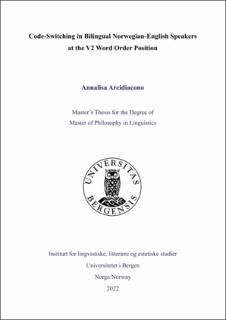Code-Switching in Bilingual Norwegian-English Speakers at the V2 Word Order Position
Master thesis
Permanent lenke
https://hdl.handle.net/11250/2998973Utgivelsesdato
2022-06-03Metadata
Vis full innførselSamlinger
- Master theses [242]
Sammendrag
This study overviews the major issues in the linguistic study of code-switching (CS), the alternating use of two languages in the same stretch of discourse by a bilingual speaker. I investigated the effect of CS to L1 Norwegian and L2 English in V2 word order sentences at the point where the V2 requirement needs to be implemented in Norwegian, but not in English because of syntactic constraints. The aim of the research is to investigate if the reaction time in the different sentence conditions will be different at the test position of the sentences. Hence, the one containing the V2 word order in the L2 to L1 sentences (1) compared to the ones that do not need the V2 word order application, thus in the L1 to L2 sentences (2). According to the predictions, it would mean that from the testing position, the second segment of the sentence where the VP is presented, the phrase would be more difficult to process due to the code switching condition and the V2 requirement. Thus, the speakers would need more time to activate a different grammar and to apply it to the grammar of the language switched to. If it is not more difficult, then that could mean that both grammars are active in parallel. Based on the findings of past research (Schwochow et al., 2021), I hypothesize that the RTs will be faster when the participant will switch from L2 English to L1 Norwegian, because even if their L2 is strong, the L1 is still the dominant language system. Moreover, I also theorize that the sentences that contain both CS and V2 will be even more difficult to process, resulting in a higher RT. The transfer of the grammatical property has been studied in L2 English learners with different L1s, but my study was mainly motivated by the work done by Johansson, Rugaard and Asperheim (2019). They investigated the effect of Code Switching (CS) to a second language (L2) in Garden Path (GP) sentences at the point of a possible GP, which had a follow up study conducted by Schwochow, Larsen and Johansson (2021). They predicted that code switching without V2 will be more accepted as it follows the predicted English word order, even when it conflicts with a grammatical rule in Norwegian. Their finding also predicts that CS involving a V2 word order change will be avoided and under-represented compared to code switching without V2. I have chosen to create the experiment according to the grammatical maze structure (Forster, 2010), where subjects were asked to select the grammatical continuation at the point of a possible V2. The GMaze was conducted for English to Norwegian (L1) with CS to L1 and with V2 word order (A), and for Norwegian to English (L2) with CS to L2 and no V2 word order (B). Code Switching: English to Norwegian (A): (A) Before eight o'clock [spiser han || han spiser] pannekaker og bacon til frokost. Norwegian to English (B): (B) Før klokka åtte [he eats|| eats he] pancakes and bacon for breakfast. I have decided to work on Schwochow, Larsen and Johansson (2021) predictions, and my data support that both CS and V2 had longer reading times compared to a baseline without CS or V2 on the individual conditions. Two baselines were selected in order to isolate the effect of CS and V2. Significant differences from the baseline were detected, but there were no specific effects of which language it was code-switched to and from, only the general CS and V2 effects. In conclusion, CS did add extra difficulty for reading or deciding on the testing sentences, but the data does not support a significant difference based on the factor of Language. A significant increase in RT was also detected when switching to L1 or L2 due to V2.
